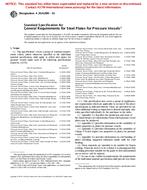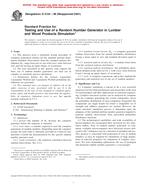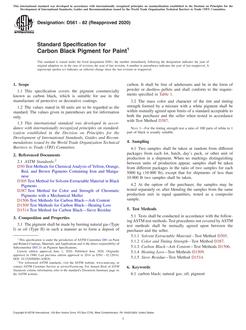1.1 This practice establishes uniform standards for estimating and expressing the precision and bias of applicable test methods for Committee D19 on Water. In principle, all test methods are covered by this practice.
1.2 Except as specified in 1.4, 1.5, and 1.6, this practice requires the task group proposing a new test method to carry out a collaborative study from which statements for precision (overall and single-operator standard-deviation estimates) and bias can be developed. This practice provides general guidance to task groups in planning and conducting such determinations of precision and bias.
1.3 This practice also provides guidance to task groups for conducting limited-scale collaborative studies (known as “comparability studies“) for test methods that have been revised, when such revision includes substantive modifications. Examples of substantive modifications may include, but are not limited to, changes in mandatory or allowable instrumentation, reagents, reaction times, etc.
1.3.1 Changes to applicable water matrices in the Scope of a method may constitute a substantive modification under this provision. However, recognize that even the original collaborative study may not have used all the various matrix types specified in the method's original Scope.
1.3.2 A method's concentration-range extension that is deemed to merit additional collaborative testing (even without a method modification that would otherwise be considered substantive) shall require a full collaborative study, as described in Sections 7.1-7.5, but only at Youden-pair concentrations representative of the extended range. Note that such a collaborative study could involve as little as a single-sample Youden-pair study in a single reproducible matrix.
1.3.3 Whether a revision to a test method includes substantive modification shall be determined by consensus of the Committee.
1.4 If a full-scale collaborative study is not technically feasible, due to the nature of the test method or instability of samples, the largest feasible scaled-down collaborative study shall be conducted to provide the best possible limited basis for estimating the overall and single-operator standard deviations.
1.4.1 Examples of acceptable scaled-down studies are the local-area studies conducted by Subcommittee D19.24 on microbiological methods because of inherent sample instability. These studies involve six or more completely independent local-area analysts who can begin analysis of uniform samples at an agreed upon time.
1.4.2 If uniform samples are not feasible under any circumstances, a statement of single-operator precision will meet the requirements of this practice. Whenever possible, this statement should be developed from data generated by independent multiple operators, each doing replicate analyses on independent samples (of a specific matrix type), which generally fall within specified concentration ranges (see 7.2.5.2 (3)).
1.4.3 This practice is not applicable to methodology involving continuous sampling or continuous measurement, or both, of specific constituents and properties.
1.4.4 This practice is also not applicable to open-channel flow measurements.
1.5 A collaborative study that satisfied the requirements of the version of this practice in force when the study was conducted will continue to be considered an adequate basis for the precision-and-bias statement required in each test method. If the study does not satisfy the current minimum requirements for a collaborative study, a statement listing the study's deficiencies and a reference to this paragraph shall be included in the precision-and-bias statement as the basis for an exemption from the current requirements.
1.6 This paragraph relates to special exemptions not clearly acceptable under 1.4 or 1.5. With the approval of Committee D19 on the recommendation of the Results Advisor and the Technical Operations Section of the Executive Subcommittee of Committee D19, a statement giving a compelling reason why compliance with all or specific points of this practice cannot be achieved will meet both ASTM requirements (1) and the related requirements of this practice. In addition, Committee D19, through a Main Committee ballot, may approve publication of a “Preliminary“ Standard Method for a period not to exceed 5 years. Preliminary Standards must contain a minimum of a single-operator precision-and-bias statement and a Quality Control section based on the single operator data. Publication of a Preliminary Standard is conditional on the approval of a full D2777 collaborative study design for the standard. Precision-and-bias statements authorized by this paragraph shall include the date of approval by Committee D19.
1.7 Per Section A21.2.3 of the ASTM Form and Style Manual the committee may delay an interlaboratory study for a new method and include a temporary statement in the Precision and Bias Section that addresses only single operator precision (“repeatability“). This statement is valid for five years from the initial publication date. In this case, a single laboratory study shall be conducted in accordance with Section 7.6.
1.8 In Section 12 this practice shows exemplary precision-and-bias-statement formats for: (1) test methods yielding a numerical measure, (2) test methods yielding a non-numerical report of success or failure based on criteria specified in the procedure, and (3) test methods specifying that procedures in another ASTM test method are to be used with only insignificant modifications.
1.9 All studies, even those exempt from some requirements under Sections 1.4 through 1.8, shall receive approval from the Results Advisor before being conducted (see Section 8) and after completion (see Section 13).
1.10 This practice satisfies the QC requirements of Practice D5847.
1.11 It is the intent of this practice that task groups make every effort to retain all the data from their round-robin studies. Values should not be eliminated unless solid evidence exists for their exclusion. The Results Advisor should work closely with the task groups to effect this goal.
Product Details
- Published:
- 01/01/2013
- Number of Pages:
- 21
- File Size:
- 1 file , 200 KB
- Redline File Size:
- 2 files , 420 KB


